Construction of roads and railways dominates the sector
The preliminary results of the 2010 Annual Survey of Philippine Business and Industry revealed that there were 713 establishments with total employment of 20 and over engaged in construction activities (Table 1). Construction of roads and railways industry reported the highest number of establishments at 306 or 42.9 percent of the total, followed by construction of buildings with 172 establishments (24.1%) and electrical, plumbing and other construction installation activities with 152 establishments (21.3%). Figure 1 shows the percentage distribution of Construction establishments by industry group in 2010.
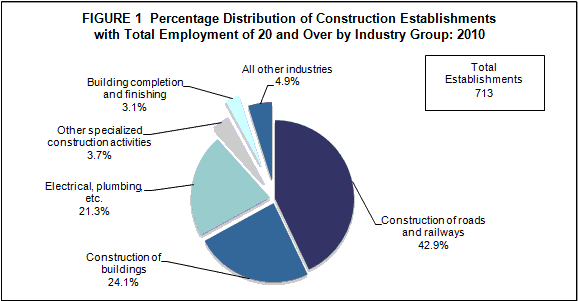
Among regions, the National Capital Region (NCR) accounted for 435 establishments or more than half of the total count of establishments. CALABARZON and Central Visayas followed a far behind with 70 (9.8%) and 46 (6.5%) establishments, respectively (Table 2).
Construction of roads and railways employs most number of worker
Construction establishments employed a total of 126,214 workers in 2010. Paid employees constituted 125,982 workers or 99.8 percent of the total while the remaining 232 workers or 0.2 percent were working owners and unpaid workers (Table 1).
By industry, construction of roads and railways, having the most number of establishments, also hired the most number of workers with 52,123 (41.3%). This was followed by construction of buildings with 42,553 (33.7%) workers and electrical, plumbing and other construction installation activities with 21,984 (17.4%) workers. Figure 2 displays the distribution of employment for Construction establishments by industry group in 2010.
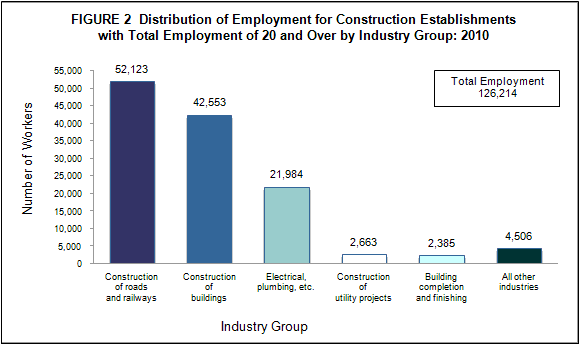
The average number of workers for establishments was recorded at 177 per establishment. Industrywise, construction of buildings topped the sector with 247 workers per establishment (Table 1a). Other top industries in terms of average number of workers were as follows:
- Construction of roads and railways with 170 workers per establishment
- Construction of utility projects with 147 workers per establishment
- Electrical, plumbing and other construction installation activities with 144 workers per establishment
- Building completion and finishing with 108 workers per establishment
Regionwise, NCR hired the most number of workers with 92,932 representing about three-fourths of the total workforce. Central Visayas and CALABARZON followed distantly with 9,226 workers (7.3%) and 7,408 workers (5.9%), respectively (Table 2).
Employees of construction of utility projects receive highest compensation
Compensation paid by Construction establishments to its workers amounted to PHP20.0 billion in 2010, translating to an average annual remuneration of PHP159,113 per employee (Table 1a).
Employees in construction of utility projects were the highest paid with an average annual pay of PHP425,266, while those employed in the electrical, plumbing and other construction installation activities were the second highest earners with an average pay of PHP 186,974. The third highest average annual remuneration was received by employees in the construction of buildings with PHP170,098. Figure 3 displays the average annual compensation of employees for Construction establishments by industry group in 2010.
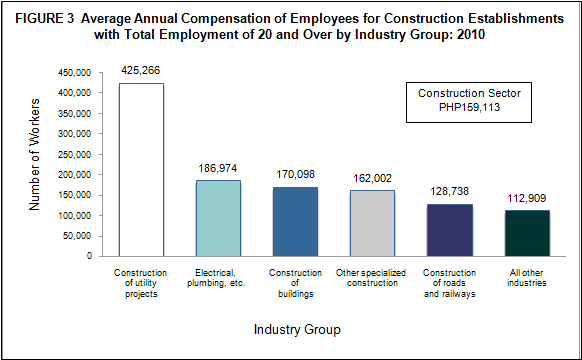
Value of output stands at PHP160.9 billion
Value of output in 2010 produced by Construction establishments amounted to PHP160.9 billion (Table 1).
By industry group, the highest value of output was generated by construction of buildings worth PHP67.0 billion accounting for 41.7 percent of total, followed by construction of roads and railways with PHP59.8 billion (37.1%). Electrical, plumbing and other construction installation activities ranked third with output value of PHP20.1 billion (12.5%). Figure 4 displays the percentage distribution of value of output for Construction establishments by industry group in 2010.
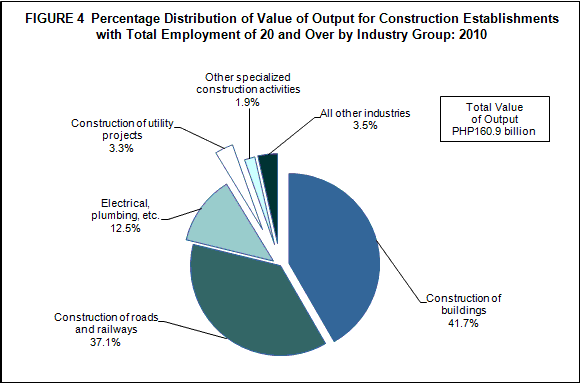
Regionwise, NCR generated PHP118.2 billion representing about three-fourths of the total output value. This was followed remotely by CALABARZON with output value of PHP8.1 billion (5.0%) and Central Visayas with PHP7.8 billion (4.8%) (Table 2).
Total cost amounts to PHP129.3 billion
Total cost incurred by Construction establishments with TE of 20 and over summed up to PHP129.3 billion in 2010. Construction of buildings was the highest spender with PHP54.5 billion (42.1%). Construction of roads and railways with PHP50.5 billion (39.0%) and electrical, plumbing and other construction installation activities with PHP14.1 billion (10.9%) were the second and third highest spenders, respectively (Table 1).
Construction of utility projects records highest returns
The ratio of total revenue to total cost was recorded at 1.25, which means that for every peso spent PHP1.25 was realized in terms of revenue (Table 1a).
Among industries, construction of utility projects recorded the highest revenue per peso cost of 1.58. Other industries in terms of revenue per peso cost are:
- Electrical, plumbing and other construction installation activities with a ratio of 1.45
- Other specialized construction activities with a ratio of 1.41
- Construction of buildings with a ratio of 1.23
- Construction of roads and railways with a ratio of 1.20
- Building completion and finishing with a ratio of 1.1
Value added reaches PHP41.4 billion
Value added generated by Construction establishments was estimated at PHP41.4 billion (Table 1).
Industrywise, construction of buildings contributed the biggest share to total value added amounting to PHP16.7 billion or 40.4 percent. Construction of roads and railways was the next highest contributor with PHP13.3 billion (32.2%) followed by electrical, plumbing and other construction installation activities with PHP7.2 billion (17.3%).
Construction of utility projects records highest labor productivity at PHP759.0 thousand
Labor productivity, defined as the ratio of value added to total employment, was estimated at PHP327.7 thousand for the Construction sector. The highest labor productivity was recorded by construction of utility projects with PHP759.0 thousand (Table1a). Other industries that surpassed the national average in terms of labor productivity are:
- Other specialized construction activities with PHP499.0 thousan
- Construction of buildings placed third with PHP392.8 thousand
Figure 5 shows the labor productivity for Construction establishments by industry group in 2010.
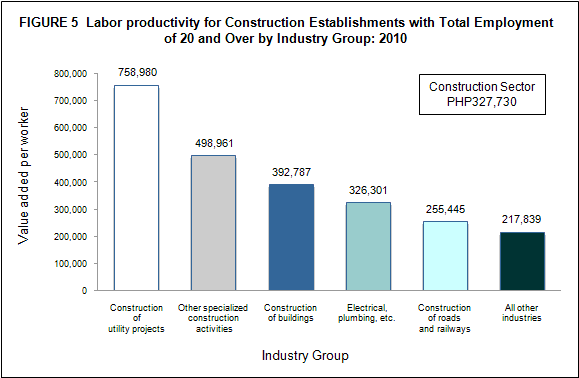
At the regional level, Cagayan Valley with PHP703,253 recorded the highest labor productivity (Table 2a). The other regions that surpassed the national average in terms of labor productivity are :
- Bicol Region with PHP681,680
- Caraga with PHP557,883
- Ilocos Region with PHP400,513
- Eastern Visayas with PHP398,061
- Davao Region with PHP364,704
- NCR with PHP345,896
- Central Luzon with PHP344,293
Gross addition to tangible fixed assets reaches PHP2.9 billion
Gross addition to fixed assets, defined as capital expenditures less sale of fixed assets, reached PHP2.9 billion. Construction of buildings acquired the highest addition to its fixed assets amounting to PHP1.2 billion or 40.3 percent of total. Construction of roads and railways ranked second with addition to fixed assets worth PHP1.1 billion (37.3%) while electrical, plumbing and other construction installation activities with PHP0.3 billion (11.4%) placed third (Table 1).
At the regional level, NCR reported the highest gross addition to fixed assets amounting to PHP2.0 billion or 66.9 percent of the total. Central Visayas and Bicol Region followed in the second and third place with PHP0.2 billion (8.1%) and PHP0.1 billion (3.9%), respectively (Table 2)
TECHNICAL NOTES
Introduction
This Special Release presents the preliminary results of the 2010 Annual Survey of Philippine Business and Industry (ASPBI) for the Construction sector for establishments with total employment of 20 and over.
The 2010 ASPBI is one of the designated statistical activities of the National Statistics Office (NSO) with the objective of providing key measures on the levels, structure, trends and performance of economic activities in the country. As such, the survey generates the most critical and essential statistics required for economic planning and policies. It was conducted in April 2011 with year 2010 as the reference period of data, except for employment which is as of November 15, 2010.
The 2009 Philippine Standard Industrial Classification (PSIC) was adopted for the first time in this survey. This is the latest version of the classification of industries in the country which conforms with the International Standard Industrial Classification Revision 4 prescribed by the United Nations.
Data are presented at the industry group or 3-digit 2009 PSIC national and regional levels.
Legal Authority
The conduct of the ASPBI is governed by legislative acts and presidential directives, mainly Commonwealth Act No. 591 which was approved on August 19,1940. Other legislative acts are:
- Presidential Decree No. 418
- Executive Order No. 121
- Executive Order No. 352
- Executive Order No. 5
Scope and Coverage
The 2010 ASPBI covered establishments engaged in 18 economic sectors classified under the 2009 PSIC, namely:
- Agriculture, Forestry and Fishing (A)
- Mining and Quarrying (B)
- Manufacturing (C)
- Electricity, Gas, Steam, and Air Conditioning Supply (D)
- Water Supply; Sewerage, Waste Management and Remediation Activities (E)
- Construction (F)
- Wholesale and Retail Trade; Repair and Maintenance of Motor Vehicles, Motorcycles (G)
- Transportation and Storage (H)
- Accommodation and Food service activities (I)
- Information and Communication (J)
- Financial and Insurance Activities (K)
- Real Estate Activities (L)
- Professional, Scientific and Technical Activities (M)
- Administrative and Support Service Activities (N)
- Education (P)
- Human Health and Social Work Activities (Q)
- Arts, Entertainment and Recreation (R)
- Other Service Activities (S)
The survey was confined to the formal sector of the economy, which consists of the following:
- Corporations and partnership
- Cooperatives and foundations
- Single proprietorship with employment of 10 and over
- Single proprietorships with branches
Unit of Enumeration
Like all other establishments surveys conducted by the NSO, the 2010 ASPBI unit of enumeration is the establishment. The establishment is defined as an economic unit under a single ownership or control which engages in one or predominantly one kind of activity at a single fixed location.
To take into account the organization and record keeping practices of construction sector by making the single location and activity criteria more flexible, the operational definition of establishments is “the unit that is engaged in the production of the most homogeneous group of goods and services, usually at one location, but sometimes over a wider area, for which separate records are available that can provide data concerning the production of these goods and services and materials, labor and physical resources used in this production.”
Sampling Design
The 2010 ASPBI used stratified systematic sampling with five-digit PSIC serving as first stratification variable and TE as the second stratification variable.
Estimation Procedure
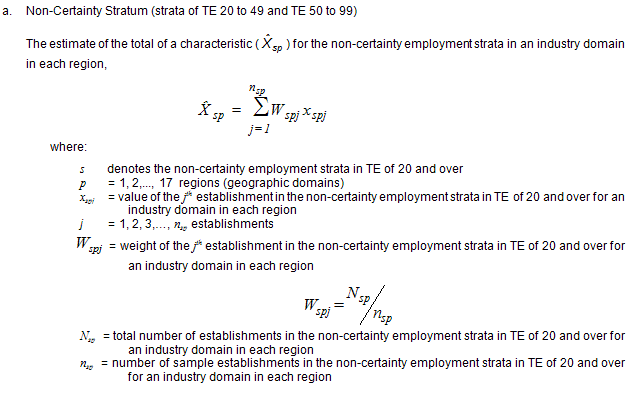
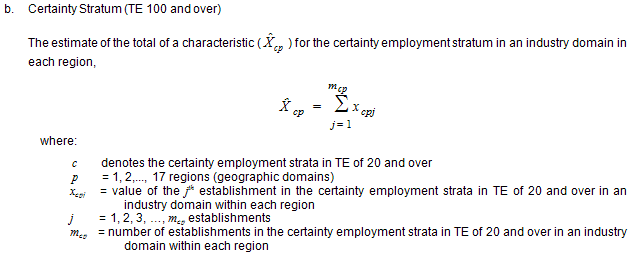

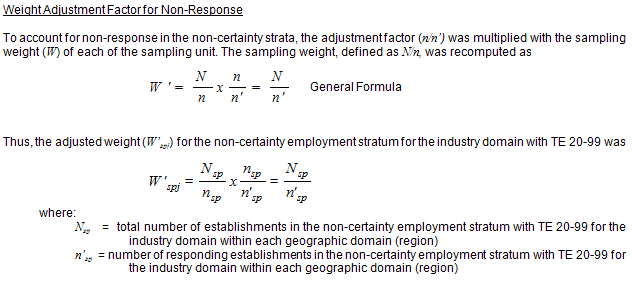
Response Rate
The response rate is 94.8 percent (474 out of 500 establishments). These include receipts of "good" questionnaires, partially accomplished questionnaires, reports of closed, moved out or out of scope establishments.
Concepts and Definitions of Terms
Economic activity is the establishment’s source of income. If the establishment is engaged in several activities, its main economic activity is that which earns the biggest income or revenue.
Total employment is the number of persons who worked in for the establishment as of November 15, 2010.
Paid employees are all persons working in the establishment and receiving pay, as well as those working away from the establishment paid by and under the control of the establishment. Included are all employees on sick leave, paid vacation or holiday. Excluded are consultants, home workers, receiving pure commissions only, and workers on indefinite leave.
Compensation includes salaries and wages, separation/retirement/terminal pay, gratuities, and payments made by the employer in behalf of the employees such as contribution to SSS/GSIS, ECC, PhilHealth, Pag-ibig, etc.
Salaries and wages are payments in cash or in kind to all employees, prior to deductions for employee’s contributions to SSS/GSIS, withholding tax, etc. Included are total basic pay, overtime pay and other benefits.
Revenue includes cash received and receivables for goods/products and by-products sold and services rendered. Valuation is at producer prices (ex-establishment), net of discounts, and allowances, including duties and taxes but excluding subsidies.
Cost refers to all expenses incurred during the year whether paid or payable. Valuation is at purchaser prices including taxes and other charges, net of rebates, returns and allowances. Goods and services received by the establishment from other establishments of the same enterprise are valued as though purchased.
Intermediate cost refers to expenses incurred in the production of goods such as materials and supplies purchased, fuels purchased, electricity purchased and industrial services done by others plus beginning inventory of materials, supplies and fuels less ending inventory of materials, supplies and fuels.
Value added is gross output less intermediate cost. Gross output for the construction sector is value of output plus non-industrial services done for others (except rent income from land). Intermediate input is intermediate cost plus non-industrial services done by others (except rent expense for land) and other costs.
Value of output represents the sum of the receipts from value of domestic construction put in place, net income from construction activities abroad, industrial services done for others, value of products manufactured and goods sold in the same condition as purchased less the cost of goods sold; and value of fixed assets produced on own account and change in inventories of construction-in-progress, finished products and work-in-progress.
Gross addition to tangible fixed assets is equal to capital expenditures less sale of fixed assets, including land.
Change in inventories is equivalent to the value of inventories at the end of the year less the value of inventories at the beginning of the year.
Inventories refer to the stock of goods owned by and under the control of the establishment as of a fixed date, regardless of where the stocks are located. Valuation is at current replacement cost in purchaser prices. Replacement cost is the cost of an item in terms of its present price rather than its original cost.
Subsidies are all special grants in the form of financial assistance or tax exemption or tax privilege given by the government to aid and develop an industry.
